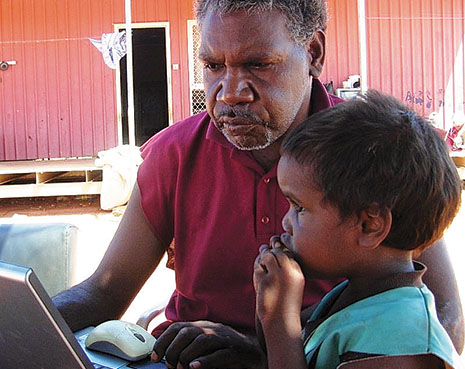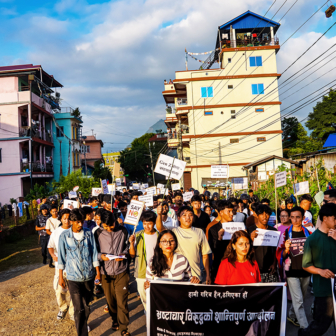ON one of my first visits to Mungalawurru, a small Aboriginal community ninety kilometres northwest of Tennant Creek, a senior man asked if he could use our Toyota LandCruiser’s high-frequency radio. His relative was in hospital and he wanted to know how the man was faring. The extended family gathered around the car as Alyson Wright, a researcher from the Central Land Council, made contact. The doctor informed everyone that the patient was awake and recovering, but his leg had been amputated. Although I didn’t ask the cause, nearly all major amputations among Indigenous Australians (98 per cent, according to one study) are associated with diabetes.
That day our radio was the only means by which the residents of Mungalawurru could contact the outside world. The one payphone in the community was out of order – a regular occurrence – and there are no home phones. A few people own mobile phones, but they must drive halfway back to Tennant Creek to make the call, along an unsealed road, to the old Warrego gold mine where you can pick up a bar or two of reception on some handsets. There was only one laptop among the twenty-two permanent residents of Mungalawurru, but it wasn’t connected to the internet.
This fairly extreme degree of isolation is about to change. I was visiting the community with researchers from the Centre for Appropriate Technology, or CAT, which provides a range of services to remote communities, including solar energy, and the Central Land Council. We were doing the groundwork for a project that will provide computers and internet access, along with training and maintenance, to households in three small communities. Kwale Kwale, forty kilometres west of Alice Springs, is the first to be connected, followed by Mungalawurru and then Imangara, which lies between Alice Springs and Tennant Creek, east off the Stuart Highway.
These are typical small communities, otherwise known as outstations. An average of five people live in each house, 43 per cent of residents received only a primary level education, and over half the working-age population is not in the labour force. The largest community, Imangara, has around ninety residents, making it fairly typical; of the 1187 Indigenous communities across Australia, 865 have a population below fifty and 987 have a population below one hundred. The dispersed and remote nature of these communities means that residents face substantial difficulties in getting access to basic services.
Aside from finding out which households want internet access, we wanted to find out why – despite government programs – people didn’t have it already and whether they saw potential benefits in being online. At the last census, in 2006, only one-in-five Indigenous households in remote and very remote Australia had an internet connection at home, compared with four-in-five of the rest of the population. In some parts of the country – including central Australia, where take-up is 2.2 per cent for Indigenous households – the figure is much lower. Our visit confirmed these low figures: although 10 per cent of residents in the three communities were using the internet from their mobile phones when visiting town, only one house (out of thirty) was connected to the internet in 2010.
We weren’t testing new satellite speeds (new satellites will beam broadband to homes in 2015) or trying out a new e-health application; we were simply attempting to connect households to the existing, standard satellite broadband, using the most commonly available equipment. The process of doing this, however, revealed the obvious ways in which broadband policy is failing to serve remote Indigenous communities – ways that have nothing to do with technology. Unfortunately, these gaps have not been resolved under the current plan for the National Broadband Network.
The government has pitched the NBN as a technology for all Australians, running fibre directly to the home for the vast majority (93 per cent), and providing next-generation wireless and satellite for the rest. Places like Mungalawurru are likely to be satellite communities; fibre won’t reach their homes and they will remain beyond the reach of wireless. (The NBN implementation plan states that getting fibre to these homes could cost up to $23,800 per dwelling.) Once the two new NBN satellites are launched, broadband will be a lot faster. The only major drawback of satellite will be transmission delays for real-time applications such as video conferencing, which is unavoidable when information is travelling into space and back.
At the retail end, though, the NBN will be business as usual. It is a government-owned wholesaler, so customers will still have to negotiate contracts with commercial internet service providers. It is this aspect – installation, billing and contracts – rather than the infrastructure that is the biggest problem for remote Indigenous households.
The federal government currently provides subsidised satellite internet to households and businesses in remote areas via a program called the Australian Broadband Guarantee. This program, which meets the full cost of end-user hardware and installation, will continue until the NBN takes over in June this year. Although the Broadband Guarantee aspires to facilitate universal access, few Indigenous households in remote communities appear to have benefited. The one person in Kwale Kwale who had an internet connection prior to our arrival had figured out for himself that he could get tolerable internet from a USB stick modem attached to a pole on the roof and connected to the house’s computer with a long cord. When we mentioned the Broadband Guarantee, or asked people if they knew about it, we were met with silence.
EVEN if the residents of Mungalawurru had known about the Broadband Guarantee, it’s not certain that they would have been able to make use of it. Andrew Crouch, CAT’s telecommunications engineer and the leader of the project, explained the process to me. To connect a computer to the internet through the Guarantee, the householder – let’s say Namikili Lauder, the senior woman in Mungalawurru – has to first run the Broadband Service Locator, an mapping tool on the federal department’s website that determines which services are available in her location. If she doesn’t have access to the internet – which is a fair assumption – she can call the department to be talked through this step over the phone. This will get her a list of about six government-registered retail satellite service providers who may, or may not, be prepared to offer and install services to Mungalawurru. She will then need to register and sign a customer declaration form, which requires that she confirm her permanent residency at the premises, and the permanency of the building itself (luckily for Namikili she does not live in a humpy or a caravan).
She can then contact the internet service providers and obtain and compare their service offerings in terms of access speeds, quotas, pricing plans, shaping versus excess charges, contract duration and any other features of interest. The signed forms and contracts are sent to the service provider. If the area is very remote then the service provider can apply to the department for an additional incentive payment to cover its additional travel expenses. The date for installation will then be set, requiring calls back and forth between the householder and the installer. The installer’s work at the community will only take about two hours – assuming that Namikili has arranged to provide a continuous 240 volt power supply. The service is then signed over to Namikili and typical billing and support processes ensue.
A few issues are likely to make all of this extremely difficult for Namikili. First, she is among the 65 per cent of people we spoke to who have never used the internet, so she’s unlikely to know what infrastructure is required to connect. One of her relatives is a regular computer user (he was the one who had the laptop in his possession when we were there) so he could help Namikili out. But when we got talking to him, he mentioned that he thought the laptop could only receive the internet in Victoria, where his sister had been using it at boarding school. He wasn’t aware of the practicalities of satellite broadband, although he did have the only subscription to the satellite television service Austar in Mungalawurru. (He happily shared access with the rest of the community, making his house popular in a community that doesn’t receive free-to-air TV.) An equally significant barrier was the fact that Namikili, or someone else in the community, would need to call the federal department to register for the Broadband Guarantee and then negotiate, over many phone calls, with the internet service providers. When there is one public phone that only works intermittently, and is only answered if someone is standing nearby, this is going to be difficult. Moreover, for many residents in remote communities, including Namikili, English is a second or third language.
Andrew, a qualified telecommunications engineer working from his well-equipped office in Alice Springs, seemed ruffled by the process at times, and particularly by the negotiations with contractors. Simply arranging a time for the installers to get to Kwale Kwale, for example, took around thirty phone calls and emails because weather conditions were affecting road access in other parts of the country. Andrew also had to make visits to the communities to check powerpoints and power supplies (Mungalawurru runs power off CAT’s Bushlight solar system, which has a predetermined daily quota, backed up by generator) and make sure that the computer equipment was protected from the power surges caused by the region’s electrical storms. At one point, a tradesman quoted $1000 to install a powerpoint for the CAT Bushlight shed, which Andrew managed to bargain down. The more complex task was figuring out the minimum number of satellite dishes the communities needed and organising wireless routers that would reach the houses and public buildings in between.
A SIMPLE step to begin overcoming these barriers would be to establish a program that works with residents in communities to sort out the best way to get satellite broadband to all houses in a community. It would handle the logistics of the task, install the equipment, check the power and possibly even come up with an appropriate way of paying for a shared facility (as opposed to the current contracts, which are intended for single households). Similar assistance programs already operate in remote Australia for a range of services, including the community phone scheme administered through the Indigenous Communications Program.
An assistance program would also resolve the issue of accountability. Last year’s NBN Implementation Study suggested that NBN Co will have done its job once the satellite beam is active, putting the responsibility for dishes and modems onto private internet service providers. For those receiving fibre to the home, however, NBN itself is responsible for installing the necessary home equipment. By delegating that final step in the process to the service providers, NBN Co will effectively avoid responsibility and public scrutiny for installation in remote communities.
Why have these basic difficulties not been resolved? One possibility is that home internet has been deemed inappropriate, or unlikely to succeed, for these households. The 2002 report, Telecommunications Action Plan for Remote Communities, which laid the basis for recent Indigenous communications policy, stated that shared facilities, such as public internet cafes, were more appropriate for what it called a “generally communal lifestyle.” The assumption is that the typical dynamics of Indigenous communities are not conducive to home computing, or that communal spaces will eventually lead to greater take-up (which is yet to be proven). On this basis, the government has made a significant investment ($6.97 million over four years, on top of previous schemes) in shared facilities in larger towns. Small communities don’t directly benefit from this funding.
The computers being installed by CAT will test whether home internet is a viable alternative to shared facilities. Although it is still early days, our initial discussions with residents gave us a good idea of what is likely to happen in Mungalawurru, Kwale Kwale and Imangara after installation has been taken care of. We were told that money is a problem; 40 per cent of people considered this to be one of the main issues that has stopped them from getting a computer. This might not only mean the cost of computers and internet subscriptions; it might also involve more complex issues to do with ownership and kinship sharing obligations. The people who already own a computer, six in total, told us that they locked away their laptops as people would “humbug” them to play games or put songs on MP3 players. When computers are scarce there is little incentive for these owners to teach others how to use computers, as this will only increase the demands placed upon them.
Housing and space were also significant issues. In one community three households were living under one roof because one family was struggling to pay the power bills and another house needed maintenance on broken taps. The older couple who lived in the house told us that they didn’t want a computer there because it would encourage people to stay indoors. Many people told us that they were worried that the kids would damage computers with food or misbehaviour. I assumed this to be an unreasonable level of concern until we returned a couple of months later to find that the only computer in Mungalawurru had a cracked screen caused by a rock thrown by a two-year-old child.
We also heard good ideas about how to handle these problems. Although we could not solve the housing issue for these communities, the couple dealing with unwanted house guests recommended that we put their computer in the large shared community shed – a kind of improvised home office. At the suggestion of the elders, CAT built a prototype lockable wooden box so that parents could control when children had access to it. At Mungalawurru, a senior woman recommended that people contribute a small amount of money to get used to paying for internet subscriptions. The older people, in particular, impressed on us the need for rules about who could use the computer at their house and when. Although these kinds of rules are established in many Australian households, the social relationships that determine who can establish rules in an Aboriginal community, and how those rules are enforced, are not the same. It will be interesting to see what this means for day-to-day computer use in a remote community.
The end result might not resemble the suburban domestic idyll of the broadband-enabled home – a private space where each family member can separately google their homework, upload videos of the cat, buy clothes from America, read a newspaper on a tablet or manage the household bills online. The families in these three communities are nonetheless keen to have computers for “kids’ schooling,” “talking to family,” “watching shows” and managing bank and Community Development Employment Program accounts.
BEYOND this, broadband might be the key to the survival of small communities. Aboriginal people live in these communities for a variety of different reasons: to maintain connection to country and sacred sites, to avoid the violence and grog in town, or because they would be marginalised in larger settlements where the traditional owners might dominate. The NT and federal governments have decided that they can no longer commit additional funding to these communities; instead, they are putting money into around thirty “priority” towns. Although it’s not explicitly stated, policies under the federal Closing the Gap program make smaller communities a lower priority for government, despite evidence that residents are often much better off than their counterparts in larger communities. Policies that centralise populations in larger settlements have been seen by some as a throwback to the assimilationist era.
By promoting e-services to regional and remote areas, broadband policy is, in theory, going against the tide. If the ambitions of the NBN are realised, choosing to live “on country” doesn’t have to mean sacrificing basic living standards or engagement with the outside world. Although the expense of undertaking an assistance program might be high, it’s worth considering what it could save in the long run. The NBN will enable e-health and e-education, connecting households with services, markets and shops, making otherwise isolated communities more viable places to live. For sufferers of chronic illness it could provide better ongoing care from health practitioners who can’t always be there in person. The NBN might not perform a remote leg amputation, but it might help prevent one in the first place. •




